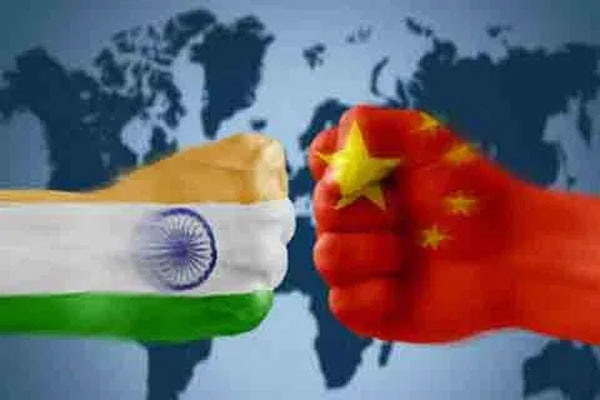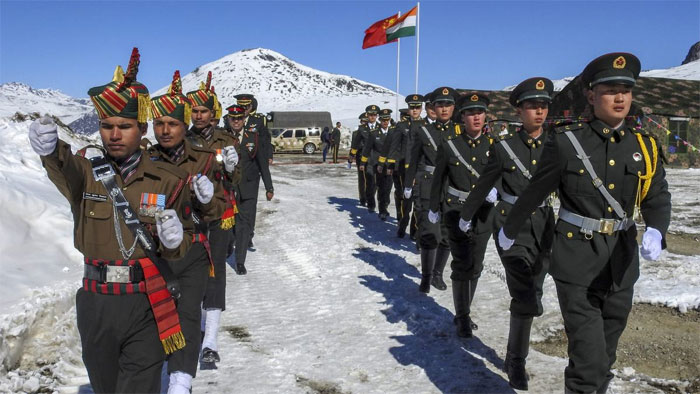CAUTIOUS ON CHINA’S ‘CHAIN OF COMMAND’
Looking back, apparently, China’s mission for an immediate land course to Pakistan was considered and somewhat executed by Chairman Mao; President Xi is attempting to finish this plan. Then, again the discussions on re-establishing business as usual bet in eastern Ladakh still can’t seem to yield noteworthy outcomes. There has apparently been withdrawal in the Galwan territory; however, the more genuine Pangong Tso and Depsang attacks presently can’t seem to be ended.

Bibhuti Pati/New Delhi
India’s blacklist of China’s Belt and Road Initiative (BRI) on grounds that the China-Pakistan Economic Corridor (CPEC) experiences Gilgit-Baltistan that was a piece of the realm of Jammu and Kashmir and, thus, has a place with India, has been seen by Beijing as compromising the security of the CPEC. Pakistan is the main nation that interfaces Beijing’s super network venture by both land and ocean and is basic to Chinese desire in West Asia. It joins Xinjiang territory with Gwadar port, near the Strait of Hormuz, through which a greater part of the world’s unrefined petroleum moves.
Gwadar’s significance has expanded as of late because of its vicinity to Iran where Beijing is solidifying a drawn out relationship dependent on common aggression toward Washington D.C.. India is a guarantee failure because of bureaucratic idleness that has neglected to execute understandings created by the political initiative. It will take extraordinary expertise (and the executives of US President Donald Trump) to revive attachments with Tehran.
China is miserable at open fights in Gilgit-Baltistan against Islamabad’s abuse and all the more as of late against the CPEC. As indicated by a knowledge report by Paul D Shinkman, national security expert, US News and World Report magazine, New Delhi sees the current imbroglio in Ladakh as proof of “Beijing’s broad colonialist plans.” China wants (huge parts of) Ladakh for simple access to Pakistan and upgraded soundness for the CPEC; angry nearby populaces would be managed harshly.
New Delhi accepts that Beijing needs to remove Indian soldiers from zones it needs to possess and inevitably interface Thang Chhenmo (wild, large desert) that China calls Aksai Chin (white stone desert go) in the wake of barging into the locale in the mid-1950s. The point is to interface Thang Chhenmo (India must begin calling the region by its unique Ladakhi name) with the Shaksgam Valley district, tallied wrongfully by Pakistan in 1963, and inevitably join Pakistan. Each move has been systematically arranged.
In April 2013, a Chinese detachment entered the Daulat Beg Oldi territory in light of a similar goal; however it pulled back a month later. Control of Daulat Beg Oldi would empower China to interface Thang Chhenmo with Siachen icy mass (at present held by India) and Karakorum Pass, where it has fabricated an all-climate street. A superficial gander at the guide shows that Pangong-Tso and Galwan Valley, where the ebb and flow deadlock is occurring, could empower China to seal the fringe of the Union Territory of Ladakh from Thang Chhenmo side and completely assimilate this enormous domain that has a place with India.
This would make it hard to guard Ladakh in case of increasingly genuine threats. India can’t permit China to dig itself in along the Thang Chhenmo fringe. As this savage landscape can be visited uniquely in summer months, China needed to manufacture framework and get the district before the appearance of winter in November. It was a genuine slip by with respect to our international strategy and national security mandarins not to foresee these moves.
The June 15 murder of 20 of the Indian Army work force close by in a hand-to-hand combat at Patrolling Point 14 of Galwan, Western Sector of Ladakh outskirt, was a striking move by China to plant its military in this key area. However, the bold reaction from Col B Santosh Babu and his men, who brought down between 35 to 53 Chinese troopers (losses not recognized right up till today) before making the incomparable penance, has fortified the national purpose to shield the fringes at any cost, a message strengthened by Prime Minister Narendra Modi and Defence Minister Rajnath Singh during late visits to Ladakh. Notwithstanding, as the stakes are a lot higher this time, Beijing’s retreat is hesitant and moderate.
The usual way of doing things at Doklam in 2017 bears assessment. The People’s Liberation Army (PLA) was occupied with a joint military exercise on the Tibetan level to test its battle proficiency when it out of nowhere crossed into an Indian area. The Doklam interruption was settled strategically, however demonstrated that Beijing has manufactured every single climate street along its fringes for quick military assembly.

Looking back, apparently China’s mission for an immediate land course to Pakistan was considered and somewhat executed by Chairman Mao; President Xi Jinping is attempting to finish this plan. The salami-cutting strategy isn’t impromptu needling of India yet a fantastic plan of specialists of the Communist Party of China. The expanded psychological militant penetration on the western front obviously makes the most of Beijing’s help. From now on, India’s military arranging should see the northern outskirts as a solitary substance. The loss of Tehran must be recognized as a discretionary screw up.
In January 2020, China led military activities in Tibet, displaying the PLA’s capacity to battle a mountain war, with the Type 15 light fight tank, the new 155-MM vehicle-mounted howitzer, helicopters, overwhelming gunnery and hostile to airplane rockets. The expanding number of military activities in Tibet in the course of recent years has accustomed the PLA to high-height conditions and India can’t bear to be smug.
Strangely, the activities were held from Lhasa up to the fringe — a message to Tibetans in Tibet and India. One miracle for whatever reason does India have a Tibetan Government in a state of banishment in the event that it considers Tibet to be a piece of China? We should fix our international strategy objectives and draw in Sikyong, Lobsang Sangay, who want a free Tibet.
India’s transition to increase its outskirts framework is honourable. Be that as it may, significantly after Maj Gen KS Thimayya altered and drove tanks up the Zoji-la in 1947, India never put resources into light tanks for mountain fighting. Even more terrible, previous Defence Minister, Manohar Parrikar’s recommendation for a Mountain Strike Corps was just struck down.
New Delhi and Washington D.C. accept that Beijing abused the Coronavirus pandemic to affirm regional cases along its outskirts, in the South China Sea, and Hong Kong. The Trump organization gave retaliatory measures against Beijing after US legislators had passed an enactment against China for restraint in Hong Kong. US Secretary of State Mike Pompeo guaranteed expanded help to partners in the South China Sea.
Eyewitnesses, communicated shock at the assurance with which Beijing proceeded onward such huge numbers of fronts at the same time, from marking Hong Kong’s self-governance and attempting to force its clout on the archipelago; to raising the stakes against India in Ladakh and charming Tehran against India; to testing Washington and emphasizing its cases in the South China Sea versus its South East Asian neighbours and Taiwan. This could demonstrate a great advancement, however Washington should help by turning impartial on Iran.
Then again, the discussions on re-establishing business as usual bet in eastern Ladakh still can’t seem to yield noteworthy outcomes. There has apparently been withdrawal in the Galwan territory; however the more genuine Pangong Tso and Depsang attacks presently can’t seem to be ended.
In the interim, India must wrestle with the outcomes of the breakdown of the system that generally kept up peace and harmony along the Line of Actual Control (LAC) and potentially its bigger relationship with its enormous northern neighbour, China.
Given the asymmetry of the territory and coordination, we have to guarantee that there are no reiterations of the Chinese moves that have occurred in the ongoing months. Preventing them from interfering into an Indian area is unendingly increasingly best, and feasible, than attempting to evacuate them from the positions they have involved. This has been the long exercise the nation has learnt since 1951. Now, the greater test is to make sense of the new direction of our relations with China.
In the first place, we should attempt to make sense of why the Chinese have done what they did. It could just be a touch of Covid-19 advantage — all things considered, China, the principal nation to be tainted, has additionally effectively pulled out of it and has got its economy moving once more. As on account of the Global Financial Crisis (GFC) of 2008, its capacity comparative with that of the others could develop in the coming time frame.

It could likewise be a result of the bewildering surrender of worldwide initiative by the US by and large and all the more explicitly during the Covid emergency. Due to the Covid pandemic the slowing economy in the US is an ideal chance to be misused. All the more so in light of the fact that the nation is up for political races in November, including the presidency.
This could clarify their concurrent moves over their fringe — in the South China Sea, with Japan in the East Sea, raising the eastern Bhutan guarantee, the crackdown in Hong Kong and the activities in eastern Ladakh. This is an ideal second for marking out their supremacy in Asia. Kurt Campbell and Mira Rapp-Hooper contend that the international strategy of restriction presented by Deng Xiaoping is at an end. ‘China is finished awaiting its chance’ is the interesting title to their ongoing article in Foreign Affairs.
The Chinese are driven by a feeling of history, and they consider their dominance as the natural order of things. Their perspective on the world is that concordance is a result of each nation tolerating its place in a framework, which is various levelled. This was maybe best placed in their White Paper on Asia Pacific Security Cooperation in 2017, which saw that ‘Significant nations should treat the key aims of others in a goal and reasonable way… (while) little and medium-sized nations need not, and ought not, favour one side among large nations.’ In the report, China recorded four ‘significant’ nations in a progressive way — the US, Russia, India and Japan. Indonesia, Vietnam, Pakistan, or Australia didn’t figure on the rundown.
The main thing that Xi Jinping did when he came to control was to discuss ‘Another Model of Great Power Relations’, a sort of code to get the US to acknowledge such a townhouse or a ‘gathering of two’ (G2) course of action. This proposition started to do the rounds in the US following the GFC, with individuals like Zbigniew Brzezinski and C Fred Bergsten supporting it.
Be that as it may, the Chinese misread the American state of mind and Obama was cold to the proposition when Xi brought it up at the Sunny lands highest point in 2013. The New Model was tied in with getting the US to acknowledge China as an equivalent which, thusly, would flag an acknowledgment of Chinese strength in the western Pacific. Rather the US started to discuss the ‘rotate’, which later turned into the Indo-Pacific approach.
Despite the fact that it discussed another model of significant force relations, the Chinese were just thinking about the US, and assuredly not India. As a huge and crowded nation, we are somewhat of a problem for China. Where would we be able to figure in the chain of command? Additionally, we have the financial and military potential to coordinate to, or even beat China.

In this way, Chinese strategy has been focused on containing India’s ascent anyway it can. Officially, Beijing proclaims fellowship and collaboration with India, yet in down to earth terms, all it has required is Pakistan to keep us reeling. Our own approach of persistent aggression towards Islamabad, obviously, helps this strategy. What’s more, our inadequacy with neighbours like Nepal and Sri Lanka exacerbates our concern.
Starting at now, we are just a possible equivalent. China’s economy is almost multiple times the size of India’s, and its military substantially more remarkable. They could yet overextend and crash, however we should not rely upon that and work at some self improvement.
The test for Indian strategy, plans and programmes is to have the option to decrease these asymmetries. This isn’t something a neighbourly Uncle will enable us to do — we have to determinedly develop our economy, upgrade our political exhibition and be undeniably progressively engaged. This can’t occur without any forethought, or even in one prime clerical term. It requires orderly short to medium-term arranging and exertion, starting at this point. As our trend lines begin angling upwards, we will get the settlements as better Chinese conduct on our fringes.

